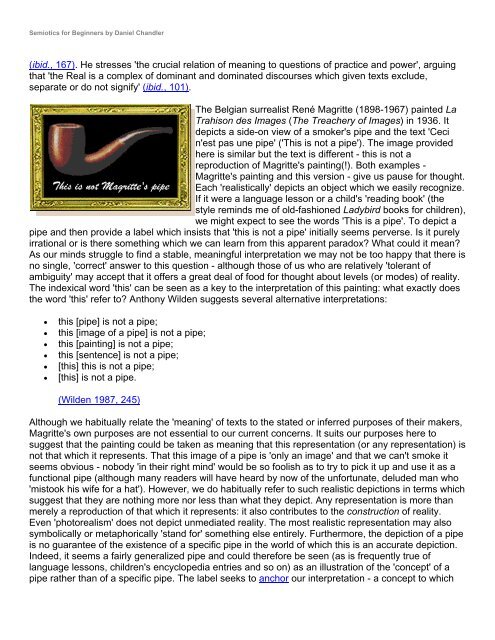Semiotics for Beginners by Daniel Chandler
Semiotics for Beginners by Daniel Chandler
Semiotics for Beginners by Daniel Chandler
Create successful ePaper yourself
Turn your PDF publications into a flip-book with our unique Google optimized e-Paper software.
<strong>Semiotics</strong> <strong>for</strong> <strong>Beginners</strong> <strong>by</strong> <strong>Daniel</strong> <strong>Chandler</strong><br />
(ibid., 167). He stresses 'the crucial relation of meaning to questions of practice and power', arguing<br />
that 'the Real is a complex of dominant and dominated discourses which given texts exclude,<br />
separate or do not signify' (ibid., 101).<br />
The Belgian surrealist René Magritte (1898-1967) painted La<br />
Trahison des Images (The Treachery of Images) in 1936. It<br />
depicts a side-on view of a smoker's pipe and the text 'Ceci<br />
n'est pas une pipe' ('This is not a pipe'). The image provided<br />
here is similar but the text is different - this is not a<br />
reproduction of Magritte's painting(!). Both examples -<br />
Magritte's painting and this version - give us pause <strong>for</strong> thought.<br />
Each 'realistically' depicts an object which we easily recognize.<br />
If it were a language lesson or a child's 'reading book' (the<br />
style reminds me of old-fashioned Ladybird books <strong>for</strong> children),<br />
we might expect to see the words 'This is a pipe'. To depict a<br />
pipe and then provide a label which insists that 'this is not a pipe' initially seems perverse. Is it purely<br />
irrational or is there something which we can learn from this apparent paradox? What could it mean?<br />
As our minds struggle to find a stable, meaningful interpretation we may not be too happy that there is<br />
no single, 'correct' answer to this question - although those of us who are relatively 'tolerant of<br />
ambiguity' may accept that it offers a great deal of food <strong>for</strong> thought about levels (or modes) of reality.<br />
The indexical word 'this' can be seen as a key to the interpretation of this painting: what exactly does<br />
the word 'this' refer to? Anthony Wilden suggests several alternative interpretations:<br />
• this [pipe] is not a pipe;<br />
• this [image of a pipe] is not a pipe;<br />
• this [painting] is not a pipe;<br />
• this [sentence] is not a pipe;<br />
• [this] this is not a pipe;<br />
• [this] is not a pipe.<br />
(Wilden 1987, 245)<br />
Although we habitually relate the 'meaning' of texts to the stated or inferred purposes of their makers,<br />
Magritte's own purposes are not essential to our current concerns. It suits our purposes here to<br />
suggest that the painting could be taken as meaning that this representation (or any representation) is<br />
not that which it represents. That this image of a pipe is 'only an image' and that we can't smoke it<br />
seems obvious - nobody 'in their right mind' would be so foolish as to try to pick it up and use it as a<br />
functional pipe (although many readers will have heard <strong>by</strong> now of the un<strong>for</strong>tunate, deluded man who<br />
'mistook his wife <strong>for</strong> a hat'). However, we do habitually refer to such realistic depictions in terms which<br />
suggest that they are nothing more nor less than what they depict. Any representation is more than<br />
merely a reproduction of that which it represents: it also contributes to the construction of reality.<br />
Even 'photorealism' does not depict unmediated reality. The most realistic representation may also<br />
symbolically or metaphorically 'stand <strong>for</strong>' something else entirely. Furthermore, the depiction of a pipe<br />
is no guarantee of the existence of a specific pipe in the world of which this is an accurate depiction.<br />
Indeed, it seems a fairly generalized pipe and could there<strong>for</strong>e be seen (as is frequently true of<br />
language lessons, children's encyclopedia entries and so on) as an illustration of the 'concept' of a<br />
pipe rather than of a specific pipe. The label seeks to anchor our interpretation - a concept to which




